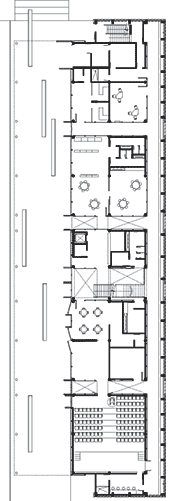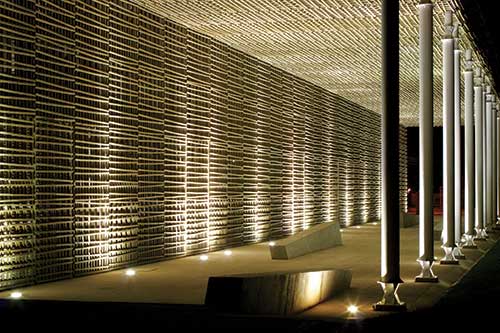Getting High Design from a Low-Tech Approach

The job of designing the library was given to four recent architecture school graduates-Miguel Torres, German Ramirez, Alejandro Piñol, and Carlos Meza-after collectively winning a national competition, their first. "We wanted the building to have a strong signature, and be very clear in terms of materials and shapes," says Meza. The designers could not have chosen a simpler material palette-quite literally sticks and stones-employing them to dramatic effect in a 16,700-square-foot rectangular structure that incorporates an outdoor plaza.
Though the concrete frame was poured on-site by a professional crew from Bogotá, much of the subsequent construction was carried out by residents of Villanueva and nearby towns, following workshops that taught the locals basic building techniques, as well as the unique methods used for this library. "This is a post-conflict area," explains Piñol. "People who are no longer engaged in violence are being reinserted into civil society. This was a way to do that."
A distinctive feature of the building that required special training to construct was the gabion wall. Nothing more than cages of rocks, gabions are more commonly used in civil engineering projects for erosion and flood control. For the library, experienced road builders from the region were brought in to supervise their assembly in 12-inch-deep wire cages along the entire 234-foot-long eastern facade. Workers experimented with the look of bisected stones in some sections of the wall, but opted to keep the rocks intact-mainly because it was less time-consuming that way. Also within the wall are four unglazed openings that feature aluminum, microperforated louvers for increased ventilation. The 31-foot-high wall wraps around the north and south elevations, as well. "Most people approach the site from the east," says Piñol. "We wanted to communicate a solid building, especially in a town that has no architectural icons whatsoever."
The small stones, which average 4 to 5 inches in diameter, were collected from nearby rivers. For the opposite side of the building, which contains a covered, outdoor space for public gatherings, the designers chose another local product. Dimensioned pine-wood pieces from regional, controlled forests are arranged in a playful pattern in modular panels that make up the wall and overhang of the plaza. "The choice of materials was intuitive," Meza says. "Even though we hoped to create a monumental building, we also wanted it to convey a local, crafted product."

For many of the library's reading, media, and meeting rooms, this lattice of sticklike pieces of pine is all that separates the interior from the exterior. Unlike Bogotá, whose mountainous terrain has a cool climate, the flat landscape surrounding Villanueva features an almost tropical one. Enclosed spaces include restrooms and a ground-floor theater, which is the only room that uses mechanical cooling.
Earthquakes and heavy rainfall characteristic of the region presented challenges to the builders. To conform to seismic regulations, foundations for the two-story building are more than 61â„2 feet deep. Each of the columns that supports the plaza's canopy-left bare to align with the clear expression of materials throughout the building-contains pin connections at the top and bottom to allow lateral movement.
 |
Giving equal attention to unbuilt space, the designers created a 27-foot-wide outdoor plaza for public gatherings. Photo © Nicolás Cabrera Andrade |
Â
The downpours typical of the rainy season are handled in the building by another striking feature, one that is concealed behind the parapet of the gabion wall. A zigzagging roof-sloping down in a west direction over large program spaces, and east over 6-foot-wide corridors-distributes rainwater to channels on both sides of the building.









